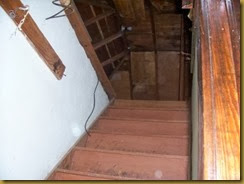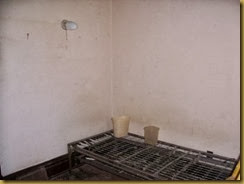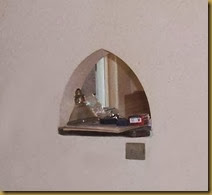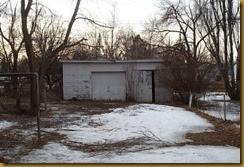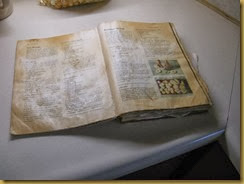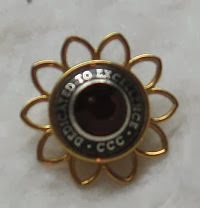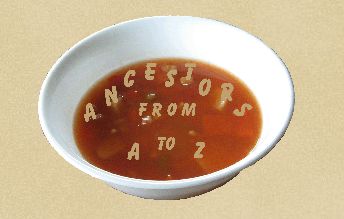
Wednesday, March 12, 2014
This is Where…
Back in 2006, we took a trip back to my grandparents’ home in South Dakota. The last of them, my grandfather, passed away in 1996, and my mother continued on there for another 9 years before moving in with us in another state. The house sat vacant. It had seen better days – wonderful days – of lots of family chatter, savory aromas from the kitchen... it was a safe haven where love and protection permeated the entire house. Everything good about life I learned in that house. And now we were going back one last time to pack things up and to say goodbye. Take a tour with me, if you will.
And, one more, if you don’t mind…
Friday, March 7, 2014
Michael Joyce: The Man Who Can’t be Pinned Down
So, when and where was Michael born? His obituary states that he was born in 1829 in Fraemstown, County Gall, Ireland. However -
-1855 Massachusetts State Census indicates 1830
-1870 Federal Census indicates 1830
-1880 Federal Census indicates 1831
-1900 Federal Census says Sept. 1830
-1910 Federal Census indicates 1830
-his obituary says Sept. 29, 1830
-his death certificate says Oct. 2, 1829
-his original headstone says Sept. 29, 1829.
And regarding his place of birth – there is no county in Ireland by the name of Gall, and “Fraemstown” appears to be nonexistent. The general vicinity for the Joyce family in County Galway has been established, but an 1781 map of the area doesn’t show “Fraemstown” or anything similar, which is a bit troubling. His wife was still living at the time of his death, and came from the same area of County Galway, so if it were she who supplied the information, one would have to give it some sort of credibility.
Michael supposedly emigrated from Ireland aboard the “Victoria” but I have not been able to find a ship by that name operating in the appropriate time and place. And when did he emigrate?
-1848, per his obituary
-1846, per the 1900 census
-1849 per the 1910 census
He married Catherine Finnerty in 1851, according to his obituary. Their first child was born in May of 1852, so this seems to fit – for a change.
They supposedly relocated from Massachusetts to Wisconsin in 1851, but birth places of their children make 1855-1857 more feasible, and a Michael and Catherine Joyce with two children by the appropriate names appear in the 1855 Massachusetts State Census, making the 1855-1857 time range more likely.
And his death? At least it’s either October 5 (death certificate and probate papers) or October 6 (original headstone). Ironically, his obituary never exactly states when he died.
My conclusion is that Michael Joyce just dropped out of the sky and landed in the United States, and from thence we all sprang. Seriously, the only solid information (I’m making a big assumption here) are the names of his parents from his death certificate. Unfortunately, his father has a common name as well (Patrick) and his mother is Rose “Maden” – or perhaps Madden. There are plenty of Maddens in the same area of Ireland as the Joyces, but no Madens that I have been able to find. Hopefully, I'll be able to find a solid piece of information that will set him apart from the others, and help me to work back back a generation or two.
Saturday, February 22, 2014
Charlotte Debolt: Making a Case for her Parentage
This blog post was inspired by Amy Johnson Crow 's "52 Ancestors in 52 Weeks" challenge. Learn more at her blog.
*******************************************
Charlotte Debolt was my fifth great-grandmother, and someone I’m still getting to know. Information has been hard to come by, particularly concerning her relationship with her husband, and discovering the identity of her parents. Charlotte was married to Daniel Debolt, a man about fifteen years her senior. They were the parents of seven children, at least that I’ve been able to identify so far. The 1820 and 1830 censuses find them in Licking county, Ohio, and in 1840, Charlotte is still there and identified as “head of household.” Daniel seems to spend the remainder of his life in the households of two of his children, but not again with Charlotte. Charlotte and several of her children removed to Peoria county, Illinois, where she passed away in 1851 and is buried in Princeville cemetery.
There’s certainly more to learn about Charlotte’s relationship with her husband, but I may be asking for too much. However, I may be having some luck in identifying her parents. I found a Charlotte Debolt listed in an index to abstracted wills in Washington county, Ohio. She was listed as an heir of Patrick Burnsides. My bubble was burst, however, when I saw that this Charlotte's husband was named William. But something kept bothering me, so I decided to see review my documentation of Charlotte.
Charlotte was born in New Jersey about 1790. I did find a Patrick Burnsides in Essex county, New Jersey in a tax list dated 1793, which of course, doesn’t prove much. In 1830, when Daniel and Charlotte lived in Licking county, Ohio, they lived next to a William Burnsides – perhaps a coincidence. I decided to go ahead and order the probate file for Patrick Burnsides from Washington County. Sure enough, right off the bat Charlotte is mentioned with her husband, William Debolt. However, further into the probate file Charlotte is mentioned again, this time with her husband named as “Daniel” DeBolt! Also listed among the heirs was William Burnsides... the same William Burnsides who lived next to Daniel and Charlotte in 1830? Hmmm....
This is not exactly ironclad proof, but I’d say I probably have the right father for Charlotte, at long last. Now, if I could just figure out why she and Daniel parted…
Saturday, February 15, 2014
Ray Christensen- Making a Night Fighter out of a Farmer
|
| Whatever
possessed Ray Christensen to do an about-face on the life he had
planned, and enlist in World War II? He was 28 years old; had two and a
half years under his belt at the University of Minnesota, and was
working on an agricultural degree; he had a job selling insurance for
State Farm, and admittedly had a “pretty good setup” living rent free as
a grounds-keeper in a women’s boarding house (not bad for a
self-proclaimed “ladies’ man!”) Agriculture was in Ray's blood, and after high school he continued to help his father on the family farm, then traveled the midwest as a hired man. Autumn of 1938 finds him at the University of Minnesota to work on a degree in agriculture. I don’t know what his plans were – go back to farming? Extension work? Something else? But he worked hard to pay his tuition, and was the first in his family to go to college. |
And
then suddenly, between semesters, he enlisted. Did the attack on Pearl
Harbor 3 weeks prior have anything to do with it? I don’t know, but
before you can say, “What happened?” he’s at Scott Field in Illinois.
| One of his first letters home says he’s learning code and electricity, and eventually will learn radios. He’ll have to “work like heck to make it,” but hopes to make the grade as a radio man on a bomber, or an instructor. His scores on the exams are high - sometimes the highest. Well, he did work like heck, and he was eventually a navigator on one of the most wild rides a soldier could get – an assignment to a night fighter squadron. | |
|
| Ray seemed to enjoy his time at Scott field – good food, comfortable bed, and only four men to a room. The food was so good, in fact, that he complained about his uniforms getting “a bit snug.” The only problem is that passes were hard to come by, even on the weekends, and for a guy like Ray who loved to dance, well, that part did not go over well. |
By June, Ray had completed
his coursework at Scott Field and has moved on to the AAFTTC Technical
School in Boca Raton, Florida, which had just officially opened for
business on June 1st.1
The
main mission of the Boca Raton AAF was radar training – a field that
was considered top secret at that time. The personnel attending this
school had to pass a “rigorous background investigation” and be among
the most highly ranked candidates academically.2 During
this time, Ray was also doing some instructing of some sort; his
letters don’t say much, but do frequently mention his students.
During
his time at Boca Raton, Ray passed the aerial gunnery board, and was
anticipating gunnery school before going “across.”
In
March of 1943, 7 months after arriving at Boca Raton, Ray is still
there, but anticipating being sent to Japan “any day now.” By the time
of his next letter in June, he has been sent to Kissimmee, Florida, and
would then go to the 417th Night Fighter Squadron by way of the British
Isles for additional training. The night fighter assignments were so
dangerous, men were considered on a volunteer basis only. I don't know
what might have prompted Ray to ask for this hazardous work - perhaps an
adventurous spirit, perhaps something else. From the British Isles, he
began his career as a night fighter navigator in the European Theater.
So much for going to Japan!
More on Ray's story in a future post~
SOURCES
Photo
of Scott Field and Radio class: “Scott Field, United States Army Air
Corps: A Pictorial and Historical Revies of Scott Field.” 1942
Various Letters from Ray Christensen to his sister, Lillian.
1Wikipedia, Boca Raton Army Airfield.
2Wikipedia, Boca Raton Army Airfield.
Thursday, February 13, 2014
The Old Cookbook
30 years ago, as a new bride, I got this Betty Crocker cookbook from my dear Aunt Mabel. It was my first cookbook, and I consulted it frequently over the years, always thinking of her when I used it. It was not only myself using it, but my children and grandchildren learned to cook with this book open on the countertop. It is missing the front cover, pages are warped from being wet, and the pages with the best recipes have little bits of this and that stuck to the paper. Here and there, pages are torn from over-anxious children wanting to see what goodies were on the next page.
Someday, when I’ve gone on to a better place, someone will be going through my belongings here on this earth. They’ll find this old cookbook and wonder why I still have it. “Was she unable to afford a new one?” they might ask. But little will they know, it’s this one that’s priceless.
Friday, February 7, 2014
William Graves of NC, OH, IL
This blog post was inspired by Amy Johnson Crow 's "52 Ancestors in 52 Weeks" challenge. Learn more at her blog.
*******************************************
covered wagon, John took ill and died. Elizabeth painfully continued the preparations and continued westward. Everyone went except Bill and Ann – Bill owned about 210 acres of land in Liberty township, nearby that of his father-in-law, Simon Ratcliff. They continued on in Ross county with their children Simon, b. 1844; Martha Madaline, b. 1846; and Saran Ann, b. 1855. Their third child, James Newton, lived less than a month and was buried at Friends Church Cemetery near Londonderry, Ohio.
Six months after the birth of her youngest child, Ann died, and was buried near her son. Six months after her death, Bill married Rebecca Stretch, daughter of Thomas and Rebecca (Rains) Stretch, who had helped out with the children after Ann’s death. About 1864, Bill, Becky, and their family set out to join the rest of Bill’s family in Illinois. Simon and “Madaline,” as she was called, went with their father, and Sarah Ann (“Annie”) stayed behind to be raised by her maternal grandparents. In addition to these two children, Bill and Becky’s family consisted of Cynthia (4) and Thomas (2), They purchased a farm in Peoria county, Illinois, just across the border from Stark county, and there they prospered. Their twin sons, Oscar and Austin, were born in 1870. Bill eventually had purchased enough land to give each of his children, including the girls, an 80-acre farm.
William apparently retired at a fairly early age, as the younger children didn’t remember him working. According to his granddaughter, Myrtis, William never hurried at anything, and was an easy going man. He “made it a point to be out at the gate when he saw a wagon coming, which in those days of slow driving was not hard to do,” she said. He always went to bed before dark, never smoked, drank, or kept late hours, and lived a long life to show for it. He was also interested in his family’s history, and kept many of the birth and death dates in his Bible. Though his people had been Quakers, Bill never professed any certain religion himself, and saw no need to “pay a preacher to tell people how to live.” This perturbed his wife to no end, having been brought up in a church-going home, and the daughter of a choir-master. He did, however, insist that his children attend Sunday school.
Rebecca suffered a fall, breaking her thigh bone, and died a month later, the official cause of death being tuberculosis. She passed away on 26 May, 1905 at the home of her daughter Cynthia. Bill then lived with his son Austin at Stringtown, just across the border in Stark county, where he died on 16 Jun 1908. Both Bill and Becky are buried at Sheets Cemetery in Stark county.
Thursday, February 6, 2014
Old Pins in a bag of "Junk"
I love to buy old buttons and pins from antique stores or garage sales. It's always interesting to see what odd things you'll find.
This is a United Hagie Seed Twine pin. Perhaps the "5" is for someone's anniversary with the company, or a landmark anniversary for the company. If you look closely you can make out the kernels of corn around the perimeter of the pin. The red bucking mule is interesting as well.
I've seen these Women's Relief Corps pins before - immediately under the badge hangs a "25 years" plaque with attachments for additional plaques for every 5 years served. The WRC is the official auxiliary to the Grand Army of the Republic (GAR).
West Midland Farmers LM pin. I don't know anything about this organization or the significance of the pin.
This is a United Hagie Seed Twine pin. Perhaps the "5" is for someone's anniversary with the company, or a landmark anniversary for the company. If you look closely you can make out the kernels of corn around the perimeter of the pin. The red bucking mule is interesting as well.
I've seen these Women's Relief Corps pins before - immediately under the badge hangs a "25 years" plaque with attachments for additional plaques for every 5 years served. The WRC is the official auxiliary to the Grand Army of the Republic (GAR).
A cute little Farm Bureau charm
West Midland Farmers LM pin. I don't know anything about this organization or the significance of the pin.
3 gallons of blood donated to the Red Cross!
I have no idea what this pin is for.
"Dedicated to Excellence - CCC"
The picture doesn't do justice to the pretty red jewel in the center. I could not find another example of this pin online, so I don't know what "CCC" stands for, or why this pin was produced.
That's all for now!
Subscribe to:
Posts (Atom)


